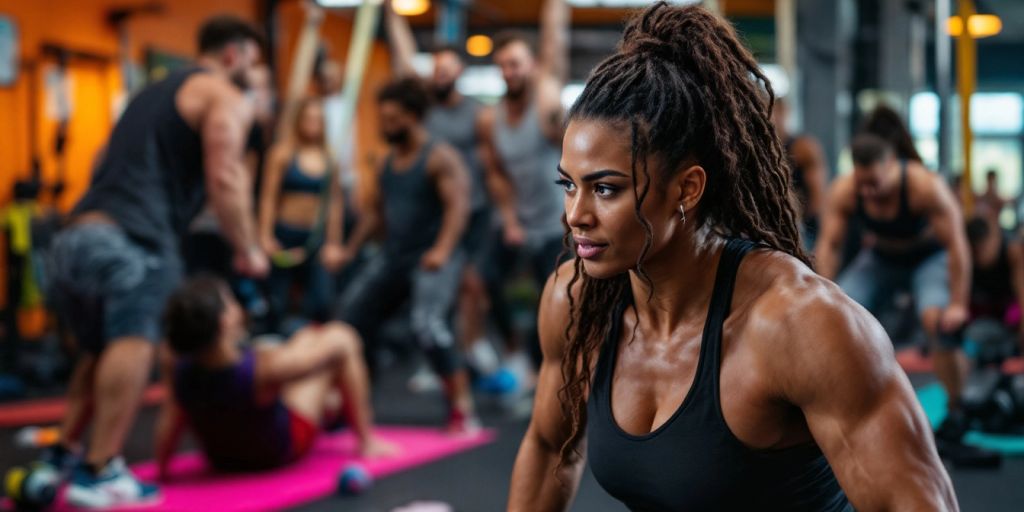
Mastering the training phase is key to unlocking your fitness potential. This phase is not just about lifting weights or running miles; it’s about understanding your body, setting clear goals, and creating a plan that works for you. With the right approach, you can overcome challenges and achieve your fitness dreams. In this article, we will explore essential aspects of the training phase and how to make the most of it.
Key Takeaways
- The training phase is crucial for understanding your body and fitness needs.
- Setting clear and achievable goals helps guide your training journey.
- An effective training program balances exercises, rest, and recovery.
- Overcoming challenges like plateaus requires strategy and adaptability.
- Nutrition and mental resilience play vital roles in achieving fitness success.
Understanding the Training Phase
Defining the Training Phase
The training phase is a specific period where you focus on improving your fitness. It involves structured workouts designed to enhance strength, endurance, and overall health. Understanding this phase is crucial for achieving your fitness goals.
Importance of the Training Phase
The training phase is essential because it helps you:
- Build strength and endurance.
- Improve your skills in various exercises.
- Prevent injuries by allowing your body to adapt.
Common Misconceptions About the Training Phase
Many people have misunderstandings about the training phase, such as:
- You need to train hard every day. In reality, rest is just as important.
- More weight equals better results. Quality of movement matters more than quantity.
- You can skip phases. Each phase builds on the last, so skipping can hinder progress.
The training phase is not just about lifting weights; it’s about creating a balanced approach to fitness that includes rest, nutrition, and mental focus.
Setting Clear Goals for Your Training Phase
Setting clear goals is essential for making progress in your fitness journey. Having specific objectives helps you stay focused and motivated. Here are some key steps to consider:
Identifying Your Fitness Objectives
- Determine what you want to achieve (e.g., weight loss, muscle gain, improved endurance).
- Break down your main goal into smaller, achievable milestones.
- Write down your goals to keep them visible and remind yourself of them regularly.
Creating a Realistic Timeline
- Set a timeline for each milestone to keep yourself accountable.
- Consider your current fitness level and how much time you can dedicate to training.
- Adjust your timeline as needed to ensure it remains realistic and achievable.
Tracking Your Progress
- Use a journal or app to log your workouts and progress.
- Regularly review your achievements and adjust your goals if necessary.
- Celebrate small victories to maintain motivation and enthusiasm.
Remember, progress takes time, and it’s important to be patient with yourself as you work towards your goals.
By following these steps, you can create a clear path to success in your training phase. This structured approach not only helps you stay on track but also allows you to enjoy the journey of reaching your fitness potential.
| Goal Type | Example Objective | Timeline |
|---|---|---|
| Weight Loss | Lose 10 pounds | 3 months |
| Muscle Gain | Increase bench press by 20 lbs | 2 months |
| Endurance | Run a 5K without stopping | 4 months |
Designing an Effective Training Program

Creating a training program that works for you is essential for reaching your fitness goals. Here are some key points to consider:
Choosing the Right Exercises
- Select exercises that match your goals. For example, if you want to build strength, focus on weightlifting.
- Include a mix of cardio, strength, and flexibility workouts to keep things balanced.
- Don’t forget to add exercises that target different muscle groups.
Balancing Different Types of Workouts
- Aim for a mix of:
- Strength Training: 2-3 times a week.
- Cardio Workouts: 3-5 times a week.
- Flexibility and Mobility Work: At least once a week.
- Rest days are important! Make sure to include them to help your body recover.
Incorporating Rest and Recovery
- Schedule rest days to prevent burnout and injuries.
- Consider active recovery, like light walking or yoga, on rest days.
- Listen to your body; if you feel tired or sore, take an extra day off.
Remember, a well-structured program not only helps you achieve your goals but also keeps you motivated and engaged.
Overcoming Challenges in the Training Phase
Dealing with Plateaus
Hitting a plateau can be frustrating, but it’s a common part of any fitness journey. To push through these tough times, consider gradually adding weight, reps, or distance to challenge your body. Here are some strategies to help you overcome plateaus:
- Change Your Routine: Switch up your exercises to target different muscle groups.
- Adjust Intensity: Increase or decrease the weight or number of sets and reps.
- Seek Help: Consult a trainer for personalized advice.
Preventing Injuries
Injuries can derail your training progress. To keep yourself safe:
- Warm Up Properly: Always start with a warm-up to prepare your muscles.
- Listen to Your Body: If something hurts, stop and rest.
- Use Correct Form: Focus on your technique to avoid strain.
Staying Motivated
Staying motivated can be tough, especially during challenging times. Here are some tips:
- Set Small Goals: Break your main goal into smaller, achievable steps.
- Track Your Progress: Keep a journal to see how far you’ve come.
- Find a Workout Buddy: Exercising with a friend can make it more fun.
Remember, overcoming challenges is part of the journey. Stay committed, and you’ll see progress!
Advanced Techniques for Mastering the Training Phase
Periodization and Its Benefits
Periodization is key to optimizing your training. It involves breaking your training into phases, each with specific goals. Here’s how to implement it:
- Set clear goals for each phase (e.g., strength, endurance).
- Adjust training variables like volume and intensity.
- Include deload weeks to prevent burnout and injuries.
| Phase | Focus | Duration |
|---|---|---|
| Preparation | Build foundation | 4 weeks |
| Strength | Increase power | 6 weeks |
| Recovery | Rest and repair | 2 weeks |
Cross-Training for Versatility
Cross-training helps you engage different muscle groups and keeps workouts fresh. Here are some activities to consider:
- Swimming for low-impact cardio.
- Cycling to build leg strength.
- Yoga for flexibility and balance.
Incorporating these can help you break through plateaus and improve overall fitness.
Utilizing Technology and Tools
Using technology can enhance your training experience. Consider:
- Fitness apps for tracking progress.
- Wearable devices to monitor heart rate and calories burned.
- Online classes for guided workouts.
By mixing different training methods, you can keep your body guessing and avoid adaptation. This approach not only boosts performance but also keeps your workouts exciting!
These advanced techniques can help you unlock your full fitness potential and keep you motivated throughout your training journey.
Nutrition and the Training Phase

Fueling Your Workouts
Proper nutrition is essential for maximizing your training results. Eating the right foods can significantly enhance your performance. Here are some key points to consider:
- Carbohydrates: They provide energy for your workouts. Aim for a slightly higher carbohydrate intake to fuel intense training sessions and replenish glycogen stores.
- Proteins: Important for muscle repair and growth. A slightly higher protein intake can help in recovery after workouts.
- Fats: Don’t forget healthy fats, which are crucial for overall health and energy.
Hydration Strategies
Staying hydrated is vital during your training phase. Here are some tips:
- Drink water before, during, and after workouts.
- Consider electrolyte drinks for longer sessions.
- Monitor your hydration levels by checking the color of your urine; it should be light yellow.
Supplements and Their Role
While whole foods should be your primary source of nutrition, some supplements can help:
- Protein powders: Useful for meeting protein needs.
- Creatine: Can enhance strength and muscle mass.
- Multivitamins: Help fill any nutritional gaps in your diet.
Nutrition plays a crucial role in your training phase. It’s not just about eating; it’s about eating smart to support your fitness goals.
Mental Strategies for Success in the Training Phase
Building Mental Resilience
Developing mental resilience is key to overcoming obstacles during your training. Here are some effective ways to strengthen your mindset:
- Focus on the process: Concentrate on the steps you need to take rather than just the end goal.
- Visualize success: Picture yourself achieving your fitness goals to boost your confidence.
- Control your breathing: Use deep breathing techniques to calm your mind and reduce stress.
Visualization Techniques
Visualization can be a powerful tool in your training. By imagining your success, you can:
- Enhance your motivation.
- Prepare mentally for challenges.
- Increase your confidence in your abilities.
Managing Stress and Recovery
Managing stress is crucial for effective training. Here are some strategies:
- Practice mindfulness: Engage in meditation or yoga to help clear your mind.
- Set realistic expectations: Understand that progress takes time and setbacks are normal.
- Take breaks: Allow yourself time to rest and recover to prevent burnout.
Remember, a strong mind can lead to a strong body. By focusing on mental strategies, you can unlock your full fitness potential.
Final Thoughts on Your Fitness Journey
In conclusion, mastering the training phase is essential for unlocking your true fitness potential. Remember, progress takes time and effort, and it’s important to be patient with yourself. By understanding the different phases of training and how they work together, you can create a balanced routine that helps you grow stronger and more capable. Don’t forget to listen to your body and make adjustments as needed. With dedication and the right approach, you can overcome obstacles and achieve your fitness goals. Keep pushing forward, and enjoy the journey!
Frequently Asked Questions
What is the training phase in fitness?
The training phase is a specific time when you focus on improving your fitness skills and strength. It helps you reach your fitness goals.
Why is the training phase important?
This phase is important because it helps you build strength, endurance, and skills, making your workouts more effective.
What are some common myths about the training phase?
Some people think that you have to push yourself to the limit every time, but it’s actually about smart training and recovery.
How can I set clear goals for my training?
You can set clear goals by thinking about what you want to achieve, making a timeline, and keeping track of your progress.
What should I do if I hit a plateau in my training?
If you hit a plateau, try changing your exercises, adjusting your workout routine, or taking a break to recover.
How does nutrition affect my training phase?
Good nutrition fuels your workouts, helps with recovery, and supports your overall fitness goals.


